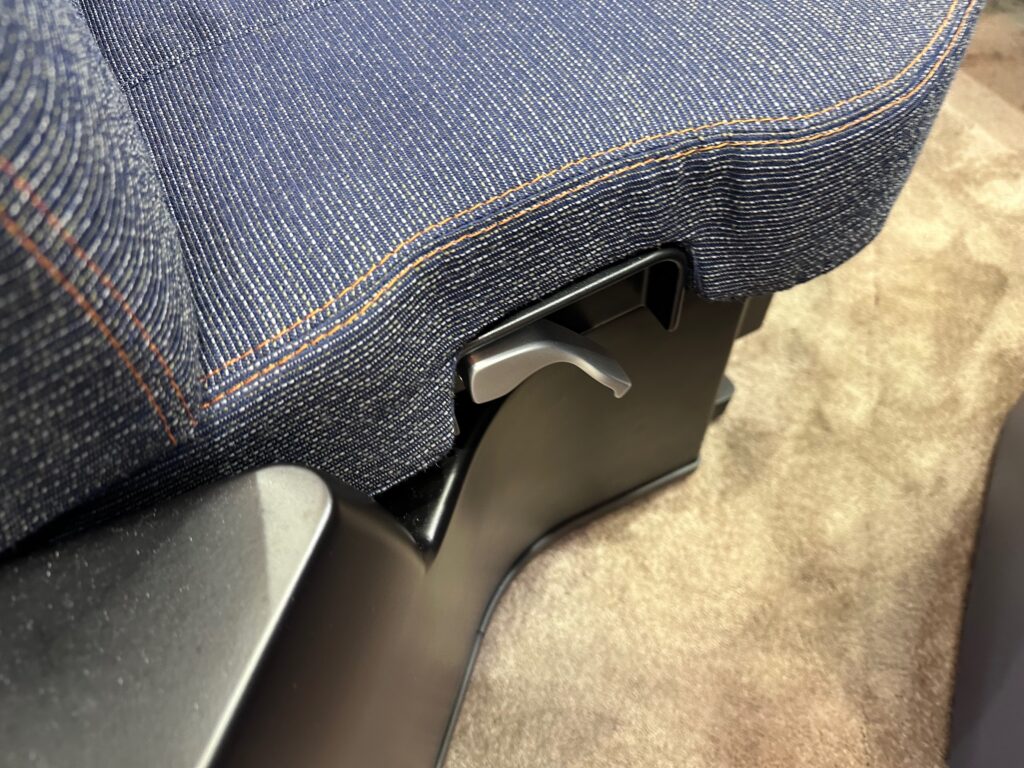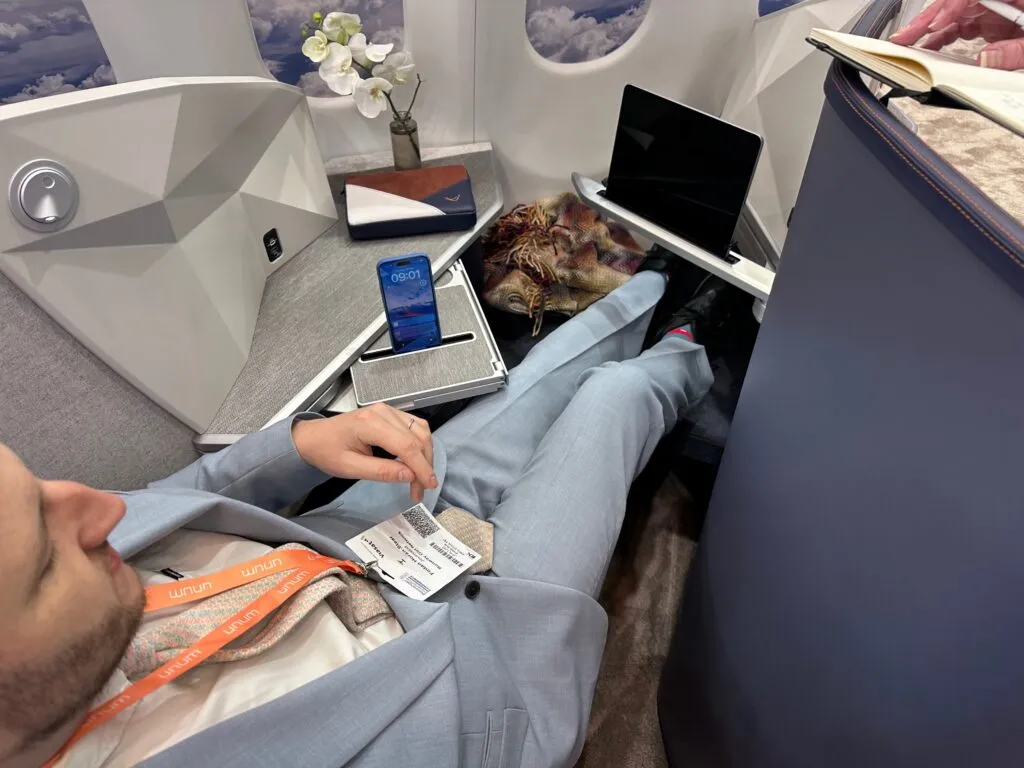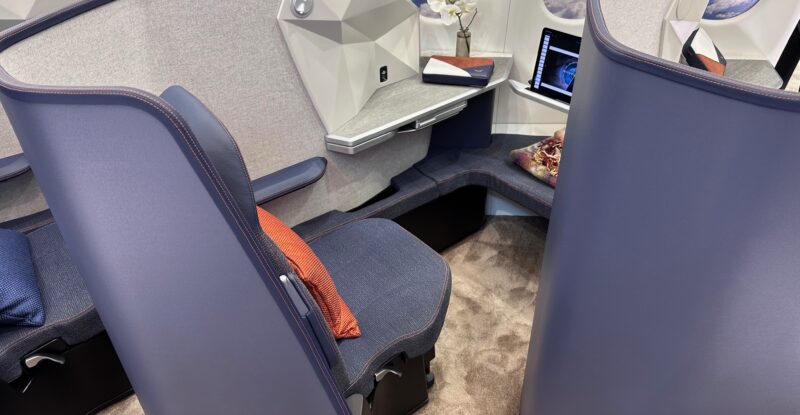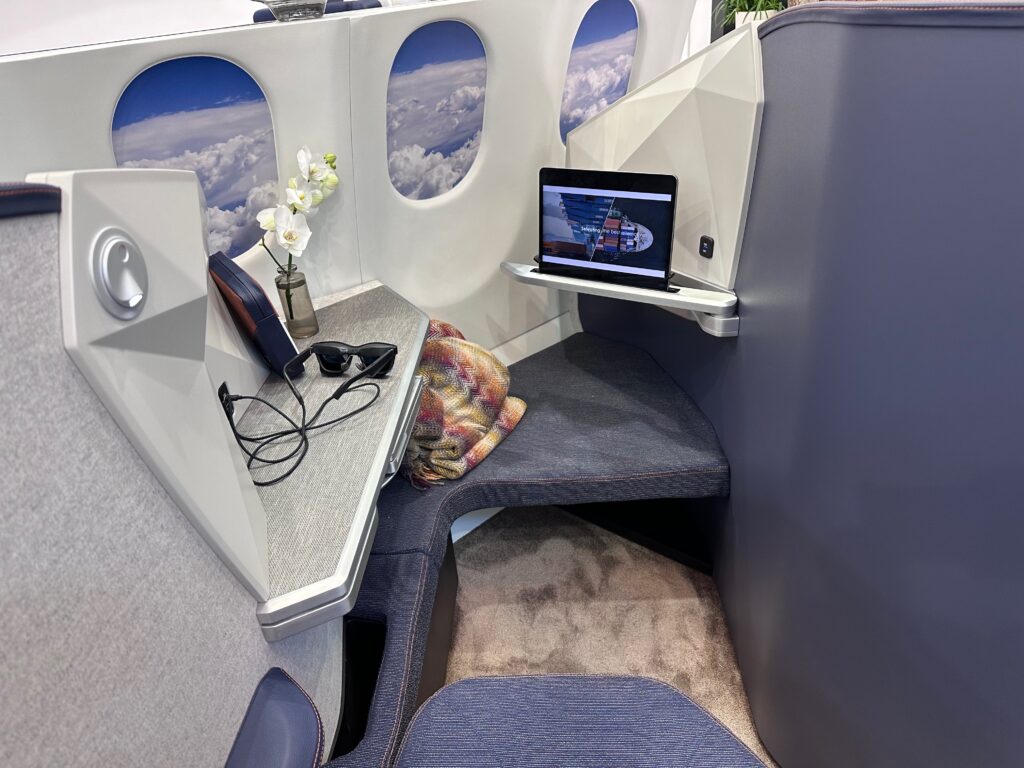 HAMBURG — How light can a business class seat be if you reduce it to its essentials — and what are those essentials for today’s traveller? That’s the question Stelia Aerospace asked at this year’s Aircraft Interiors Expo with its new outward-facing herringbone Opera Essential seat, designed to reduce carbon emissions.
HAMBURG — How light can a business class seat be if you reduce it to its essentials — and what are those essentials for today’s traveller? That’s the question Stelia Aerospace asked at this year’s Aircraft Interiors Expo with its new outward-facing herringbone Opera Essential seat, designed to reduce carbon emissions.
By turning the electronic recline system into a manual kinetic movement, and by eschewing inflight entertainment screens — and the 1.5 tonnes of wiring and other associated weight that comes with them — Stelia has created a honed-down business class product for industry consideration.
The numbers are certainly impressive. Vice president of global sales and marketing Alain Bordeau told Runway Girl Network that, compared with the seatmaker’s standard Opera product for single-aisles, Opera Essential features “40% fewer mechanical parts, 96% fewer electronic parts. The weight is 65kg, so it’s 30% less. It’s 32% less carbon footprint.”
Stelia believes there are further reductions to be made: without a door, the seatmaker is targeting 65kg, and that’s with the thermoplastic rear shell on the stand, which optimises for circularity of production via eventual recycling rather than optimising purely for weight. A composite option, Bordeau estimates, could add a further 20% weight savings.
Two RGN journalists tried out Opera Essential on the stand at AIX, first during a packed first morning press tour and later during a more in-depth late afternoon visit. The beauty of the seat is in the mechanism, and here the kinematics were impressive, essentially an advanced version of a choice between an automotive seat with a manual lever for recline rather than a series of more precisely adjustable buttons.

The single-pull lever allows for a surprising amount of granularity in the recline to bed mode, as shown on the Stelia stand at AIX. Image: John Walton
It’s a matter of pulling up on the lever to slide the seat to the reclined (or fully flat) position you desire, then releasing the lever. Returning to the seated position from flat, there’s a bit of a pilates core muscle trick to finding the precise point at which to place your body weight on the seat in order to activate the slide of the kinematics, but this took only a couple of tries and then we had it down pat.
 In bed mode, the lack of integrated IFE screens was particularly notable in the amount of space it releases back to the passenger, even for your tall, broad six-foot-plus journalists.
In bed mode, the lack of integrated IFE screens was particularly notable in the amount of space it releases back to the passenger, even for your tall, broad six-foot-plus journalists.
Opera Essential feels like a front-row-business-plus amount of space even in a subsequent row within the cabin. The lack of IFE also means that each passenger has a good two and a half windows’ worth of space, making Opera Essential feel even more spacious.
To compensate for the lack of in-seat IFE, Stelia is offering a tablet arm that slides out from the seat frame in front, as well as a slot for smaller tablets or phones within the table assembly. Both work well, and are marked improvements on previous implementations of the tablet arm concept (notably the Optimares Maxima pivot-arm for Hawaiian Airlines and the revised first-generation British Airways Mohawk “flappy fan” forwards-backwards business class flatbeds installed on the French OpenSkies BA subsidiary). Power via USB-A and -C is on offer to keep devices topped up.

The tablet arm feels well engineered, although it may need some futureproofing in terms of eventual tablet sizing. Image: John Walton
To our minds, Stelia has answered the kinematic question well: not only is this not a major user interface issue for most passengers, some (or even many) are likely to find this an improvement over jabbing at the usual tiny buttons with incomprehensible diagrams, or being surprised when resting an arm on a capacitative touch-surface that starts their seat moving.
The question of IFE is more open. In theory, enough passengers now travel with their own larger-screened devices, whether traditional laptop or tablet, that this need not be a complete dealbreaker. Stelia’s Bordeau highlighted the number of frequent flyers who quickly exhaust the IFE of interest, although it feels like substantial advances on streaming IFE installation may be needed to truly avoid passengers feeling hard done by.
If (and this is a big if) airlines can up their pre-flight communications game to highlight that a flight will not have embedded IFE, and to sweeten the deal with some onboard streaming partnerships — think Thales’ FlytEDGE — then the Essential questions may well be answered.

The tablet arm feels well engineered, although it may need some futureproofing in terms of eventual tablet sizing. Image: John Walton
Related Articles:
- Stelia takes focused approach to perceived seat quality
- Airbus and Stelia show off new C Suite ultra-compact narrowbody seat
- Stelia reveals Opera herringbone for Air France A350, linefit 787s
All images credited to John Walton













